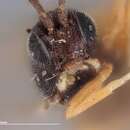Distribution
provided by Catalog of Hymenoptera in America North of Mexico
Fla.
- bibliographic citation
- Catalog of Hymenoptera in America North of Mexico. 1979. Prepared cooperatively by specialists on the various groups of Hymenoptera under the direction of Karl V. Krombein and Paul D. Hurd, Jr., Smithsonian Institution, and David R. Smith and B. D. Burks, Systematic Entomology Laboratory, Insect Identification and Beneficial Insect Introduction Institute. Science and Education Administration, United States Department of Agriculture.
Comprehensive Description
provided by Smithsonian Contributions to Zoology
Orgilus notabilis
In some respects this species is very similar to tenuis, new species, but it is readily distinguished by the partly margined occiput, the extraordinarily long and narrow radial cell, the much longer calcaria of the hind tibiae, the annulate antennae in the female, and the general body color.
FEMALE.—Length about 3.2 mm. Head conspicuously wider than thorax, more than twice as wide as long in dorsal view; face a little narrower than eye height, finely granulose and rather mat; temples very narrow, receding sharply from the eye margins; occiput margined only laterally below level of the middle of the eyes; clypeus smooth and shiny; eyes very large; malar space about one-sixth as long as eye height and less than half as long as longest segment of maxillary palpus; maxillary palpi at least as long as width of face; frons and vertex finely granulose; diameter of a lateral ocellus slightly less than distance between lateral ocelli and about half as long as ocellocular line; antennae of holotype 35-segmented, even the shortest flagellar segments longer than broad.
Thorax very slender; mesoscutum finely granulose; notauli sharply impressed and finely foveolate; disc of scutellum shagreened; propodeum coriaceous and with very short spurs of longitudinal carinae arising from the posterior margin and setting off five apical areas that are open in front; side of pronotum, mesopleuron, and metapleuron coriaceous, the longitudinal furrow of mesopleuron weakly indicated. Hind coxa elongate, about half as long as thorax, its surface coriaceous; hind femur about five times as long as wide; inner calcarium of hind tibia fully half as long as metatarsus; tarsal claws simple. Radial cell going nearly to extreme apex of wing and on wing margin at least one and one-half times as long as stigma; radius arising from well beyond middle of stigma; second abscissa of radius more than eight times as long as first; not even a vestige of third abscissa of cubitus present; nervulus postfurcal by nearly half its length; hind wing about six times as long as wide; lower abscissa of basella twice as long as nervellus, three-fourths as long as mediella and at least four-fifths as long as maximum width of hind wing.
Abdomen very slender; first tergite twice as long as wide on posterior margin, finely rugulose and with the basal dorsal keels strong and extending to the middle of the tergite; second tergite longer than broad at base and about as long as broad at apex, finely rugulose punctate; third tergite wider than long, entirely confluently punctate; fourth and fifth tergites largely smooth and shiny but a little shagreened medially; ovipositor sheath a little longer than head, thorax, and abdomen combined.
Brownish yellow; antennal flagellum dark brown but with segments 9–16 white; second and third tergites slightly darkened medially; legs entirely, also tegulae and wing bases, brownish yellow; wings hyaline.
MALE.—Unknown.
HOLOTYPE.—USNM 70186.
DISTRIBUTION.—Known only from the holotype female which was collected in a black-light trap at Miami, Florida. This is the only Nearctic specimen with annulated antennae I have seen, although the U.S. National Museum collection contains specimens of several apparently undescribed Neotropical species of Orgilus with conspicuously banded antennae. It is quite possible that the type of notabilis is a wanderer from the West Indies.
- bibliographic citation
- Muesebeck, Carl F. W. 1970. "The Nearctic species of Orgilus Haliday (Hymenoptera: Braconidae)." Smithsonian Contributions to Zoology. 1-104. https://doi.org/10.5479/si.00810282.30

